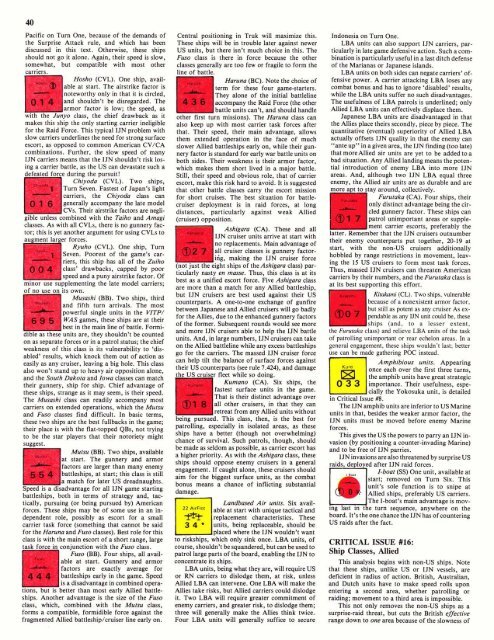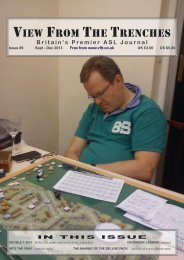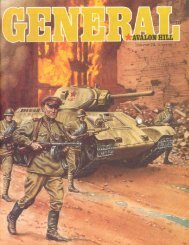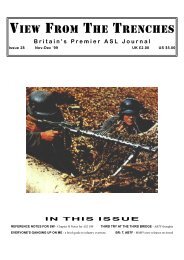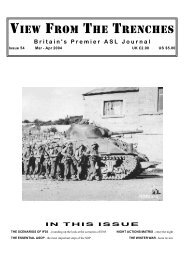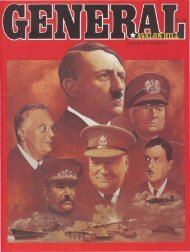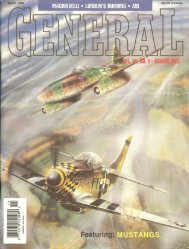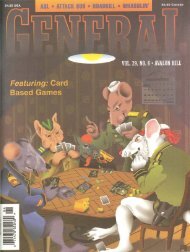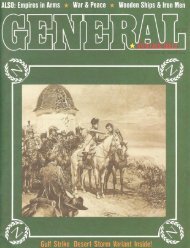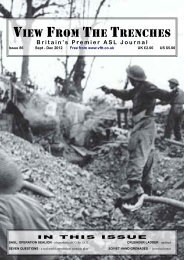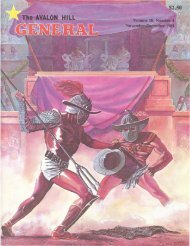18.64MB - View From The Trenches
18.64MB - View From The Trenches
18.64MB - View From The Trenches
- TAGS
- trenches
- www.vftt.co.uk
Create successful ePaper yourself
Turn your PDF publications into a flip-book with our unique Google optimized e-Paper software.
Pacific on Turn One, because of the demands of<br />
the Surprise Attack rule, and which has been<br />
discussed in this text. Otherwise, these ships<br />
should not go it alone. Again, their speed is slow,<br />
somewhat, but compatible with most other<br />
carriers.<br />
I Hosho (CVL). One ship, avail-<br />
'able at start. <strong>The</strong> airstrike factor is<br />
noteworthy only in that it is circled,<br />
land shouldn't be disregarded. <strong>The</strong><br />
larmor factor is low; the speed, as<br />
with the Junyo class, the chief drawback as it<br />
makes this ship the only starting carrier ineligible<br />
for the Raid Force. This typical IJN problem with<br />
slow carriers underlines the need for strong surface<br />
escort, as opposed to common American CV/CA<br />
combinations. Further, the slow speed of many<br />
IJN carriers means that the IJN shouldn't risk los-<br />
ing a carrier battle, as the US can devastate such a<br />
defeated force during the pursuit!<br />
Chiyoda (CVL). Two ships,<br />
Turn Seven. Fastest of Japan's light<br />
carriers, the Chiyoda class can<br />
- generally accompany the late model<br />
CVs. <strong>The</strong>ir airstrike factors are negli-<br />
gible unless combined with the Taiho and Amagi<br />
classes. As with all CVLs, there is no gunnery fac-<br />
tor; this is yet another argument for using CVLs to<br />
nent larger forces.<br />
Ryuho (CVL). One ship, Turn<br />
Seven. Poorest of the game's car-<br />
riers, this ship has all of the Zuiho<br />
class' drawbacks, capped by poor<br />
speed and a puny airstrike factor. Of<br />
epplementing the late model carriers;<br />
: on its own.<br />
1 Musashi (BB). Two ships, third<br />
and fifth turn arrivals. <strong>The</strong> most<br />
powerful single units in the VZTP/<br />
WAS games, these ships are at their<br />
best in the main line of battle. Formi-<br />
dible as these units are, they shouldn't be counted<br />
on as separate forces or in a patrol status; the chief<br />
weakness of this class is its vulnerability to 'dis-<br />
abled' results, which knock them out of action as<br />
easily as any cruiser, leaving a big hole. This class<br />
also won't stand up to heavy air opposition alone,<br />
and the South Dakota and Iowa classes can match<br />
their gunnery, ship for ship. Chief advantage of<br />
these ships, strange as it may seem, is their speed.<br />
<strong>The</strong> Musashi class can readily accompany most<br />
carriers on extended operations, which the Mutsu<br />
and Fuso classes find difficult. In basic terms,<br />
these two ships are the best fullbacks in the game;<br />
their place is with the flat-topped QBs, not trying<br />
to be the star players that their notoriety might<br />
suggest.<br />
Mutsu (BB). Two ships, available<br />
at start. <strong>The</strong> gunnery and armor<br />
factors are larger than many enemy<br />
battleships, at start; this class is still<br />
a match for later US dreadnaughts.<br />
Speed is a disadvantage for all IJN game starting<br />
battleships, both in terms of strategy and, tac-<br />
tically, pursuing (or being pursued by) American<br />
forces. <strong>The</strong>se ships may be of some use in an in-<br />
dependent role, possibly as escort for a small<br />
carrier task force (something that cannot be said<br />
for the Haruna and Fuso classes). Best role for this<br />
class is with the main escort of a short range, large<br />
'ask force-in conjunction with the Fuso class.<br />
Fuso (BB). Four ships, all avail-<br />
able at start. Gunnery and armor<br />
I<br />
factors are exactly average for<br />
battleships early in the game. Speed<br />
is a disadvantage in combined operations,<br />
but is better than most early Allied battleships.<br />
Another advantage is the size of the Fuso<br />
class, which, combined with the Mutsu class,<br />
forms a compatible, formidible force against the<br />
fragmented Allied battleship/cruiser line early on.<br />
Central positioning in Truk will maximize this.<br />
<strong>The</strong>se ships will be in trouble later against newer<br />
US units, but there isn't much choice in this. <strong>The</strong><br />
Fuso class is there in force because the other<br />
classes generally are too few or fragile to form the<br />
line of battle.<br />
Haruna (BC). Note the choice of<br />
term for these four game-starters.<br />
<strong>The</strong>y alone of the initial battleline<br />
accompany the Raid Force (the other<br />
,battle units can't, and should handle<br />
other first turn missions). <strong>The</strong> Haruna class can<br />
also keep up with most carrier task forces after<br />
that. <strong>The</strong>ir speed, their main advantage, allows<br />
them extended operation in the face of much<br />
slower Allied battleships early on, while their gun-<br />
nery factor is standard for early war battle units on<br />
both sides. <strong>The</strong>ir weakness is their armor factor,<br />
which makes them short lived in a major battle.<br />
Still, their speed and obvious role, that of carrier<br />
escort, make this risk hard to avoid. It is suggested<br />
that other battle classes carry the escort mission<br />
for short cruises. <strong>The</strong> best situation for battle-<br />
cruiser deployment is in raid forces, at long<br />
distances, particularly against weak Allied<br />
(cruiser) opposition.<br />
Ashigara (CA). <strong>The</strong>se and all<br />
IJN cruiser units arrive at start with<br />
no replacements. Main advantage of<br />
all cruiser classes is gunnery factor-<br />
iig, making the IJN cruiser force<br />
(not just the eight ships of the Ashigara class) par-<br />
ticularly nasty en masse. Thus, this class is at its<br />
best as a unified escort force. Five Ashigara class<br />
are more than a match for any Allied battleship,<br />
but IJN cruisers are best used against their US<br />
counterparts. A one-to-one exchange of gunfire<br />
between Japanese and Allied cruisers will go badly<br />
for the Allies, due to the enhanced gunnery factors<br />
of the former. Subsequent rounds would see more<br />
and more IJN cruisers able to help the IJN battle<br />
units. And, in large numbers, IJN cruisers can take<br />
on the Allied battleline while any excess battleships<br />
go for the carriers. <strong>The</strong> massed IJN cruiser force<br />
can help tilt the balance of surface forces against<br />
their US counterparts (see rule 7.424), and damage<br />
the US cruisc r fleet while so doing.<br />
Kumano (CA). Six ships, the<br />
fastest surface units in the game.<br />
That is their distinct advantage over<br />
all other cruisers, in that they can<br />
iretreat from any Allied units without<br />
being pi :d. This class, then, is the best for<br />
patrolling, especially in isolated areas, as these<br />
ships have a better (though not overwhelming)<br />
chance of survival. Such patrols, though, should<br />
be made as seldom as possible, as carrier escort has<br />
a higher priority. As with the Ashigara class, these<br />
ships should oppose enemy cruisers in a general<br />
engagement. If caught alone, these cruisers should<br />
aim for the biggest surface units, as the combat<br />
bonus means a chance of inflicting substantial<br />
damage.<br />
Landbased Air units. Six avail-<br />
able at start with unique tactical and<br />
replacement characteristics. <strong>The</strong>se<br />
units, being replaceable, should be<br />
placed where the IJN wouldn't want<br />
to riskships, which only sink once. LBA units, of<br />
course, shouldn't be squandered, but can be used to<br />
patrol large parts of the board, enabling the IJN to<br />
concentrate its ships.<br />
LBA units, being what they are, will require US<br />
or RN carriers to dislodge them, at risk, unless<br />
Allied LBA can intervene. One LBA will make the<br />
Allies take risks, but Allied carriers could dislodge<br />
it. Two LBA will require greater commitment of<br />
enemy carriers, and greater risk, to dislodge them;<br />
three will generally make the Allies think twice.<br />
Four LBA units will generally suffice to secure<br />
Indonesia on Turn One.<br />
LBA units can also support IJN carriers, particularly<br />
in late game defensive action. Such a combination<br />
is particularly useful in a last ditch defense<br />
of the Marianas or Japanese islands.<br />
LBA units on both sides can negate carriers' offensive<br />
power. A carrier attacking LBA loses any<br />
combat bonus and has to ignore 'disabled' results,<br />
while the LBA units suffer no such disadvantages.<br />
<strong>The</strong> usefulness of LBA patrols is underlined; only<br />
Allied LBA units can effectively displace them.<br />
Japanese LBA units are disadvantaged in that<br />
the Allies place theirs secondly, piece by piece. <strong>The</strong><br />
quantitative (eventual) superiority of Allied LBA<br />
actually offsets IJN quality in that the enemy can<br />
"ante up" in a given area, the IJN finding (too late)<br />
that moreAllied air units are yet to be added to a<br />
bad situation. Any Allied landing means the potential<br />
introduction of enemy LBA into more IJN<br />
areas. And, although two IJN LBA equal three<br />
enemy, the Allied air units are as durable and are<br />
ore apt to stay around, collectively.<br />
1 !<br />
Furutaka (CA). Four ships, their<br />
only distinct advantage being the circled<br />
gunnery factor. <strong>The</strong>se ships can<br />
patrol unimportant areas or supplement<br />
carrier escorts, preferably the<br />
1 tter. Remember that the IJN cruisers outnumber<br />
their enemy counterparts put together, 20-19 at<br />
start, with the non-US cruisers additionally<br />
hobbled by range restrictions in movement, leaving<br />
the 15 US cruisers to form most task forces.<br />
Thus, massed IJN cruisers can threaten American<br />
carriers by their numbers, and the Furutaka class is<br />
st its best slloporting this effort.<br />
Kitakami (CL). Two ships, vulnerable<br />
because of a nonexistent armor factor,<br />
but still as potent as any cruiser As expendable<br />
as any UN unit could be, these<br />
-lips (and. to a lesser extent,<br />
SS) and relieve LBA units of the task<br />
of patrolling unimportant or rear echelon areas. In a<br />
general engagement, these ships wouldn't last; better<br />
use can be made gathering POC instead.<br />
I Amphibious units. Appearing<br />
once each over the first three turns,<br />
the amphib units have great strategic<br />
I importance. <strong>The</strong>ir usefulness, espe-<br />
cially the Yokosuka unit, is detailed<br />
In Critical Issue #8.<br />
<strong>The</strong> IJN amphib units are inferior to US Marine<br />
units in that, besides the weaker armor factor, the<br />
IJN units must be moved before enemy Marine<br />
forces.<br />
This gives the US the powers to parry an IJN in-<br />
vasion (by positioning a counter-invading Marine)<br />
and to be free of IJN parries.<br />
IJN invasions are also threatened by surprise US<br />
raids, deployed after IJN raid forces.<br />
I-boat (SS) One unit, available at<br />
board. It's the one chance the IJN has of countering<br />
US raids after the fact.<br />
CRITICAL ISSUE #16:<br />
Ship Classes, Allied<br />
This analysis begins with non-US ships. Note<br />
that these ships, unlike US or IJN vessels, are<br />
deficient in radius of action. British, Australian,<br />
and Dutch units have to make speed rolls upon<br />
entering a second area, whether patrolling or<br />
raiding; movement to a third area is impossible.<br />
This not only removes the non-US ships as a<br />
surprise-raid threat, but cuts the British effective<br />
range down to one area because of the slowness of


